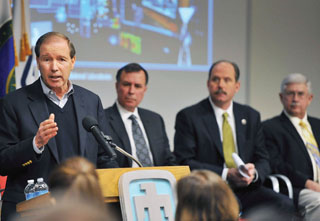
An unusual urgency underlay the brief speeches noting the formal opening of Sandia’s Cyber Engineering Research Laboratory (CERL) on Feb. 19.
This was possibly because of a warning of “malicious cyber activity” released the previous day by the FBI and the Department of Homeland Security, and the growing flood of news releases from large institutions announcing — sometimes admitting — they had been cyberhacked.
The building — located in Sandia’s Research Park — is expected to serve as a venue to bring together expertise from across Sandia, as well as from universities and businesses, to develop innovative solutions against the increasingly serious challenges posed by hackers and
cybercriminals to individuals, business, and government.
US Sen. Tom Udall, D-N.M., mentioned Winston Churchill’s book While England Slept, which in 1938 criticized the English government’s lack of preparation against the threat from Nazi Germany. Said Udall, “Cyberthreat is not one of guns and tanks but we need to take it seriously. . . . The threat is real to . . . our water systems, oil pipelines, hospital systems . . . and we should bring justice to those who would do us harm. CERL is a crucial part of our defenses.”
Challenge can’t be taken on alone
Said Sandia President Paul Hommert, “[Cybercrime] can’t be tackled alone. The public and private worlds must combine efforts to work as a team.” Sandia’s cyberexpertise, he said, is rooted in its nuclear weapons history.
He mentioned Sandia’s Center for Cyberdefenders’ student internship program (www.sandia.gov/ccd), which has worked with more than 300 students in the past decade to hone the skills of next-generation cyber workers.
Other CERL projects include marrying algorithms and data in attempts to prevent adversaries from penetrating emails or damaging websites.
US Rep. Ben Ray Lujan, D-N.M.-3rd, mentioned that “[cyberdefense] is critically important to our economy. Work at Sandia and Los Alamos national labs should lead to partnerships with private businesses.” In terms of security, “personal information taken and used in some way, from an ATM machine or anywhere else, can allow someone from around the world to get into something personal [of a citizen’s here]. . . . People in Virginia [at security agencies] seem to have connected the dots and released . . . information about the current threats.”
NNSA official Dimitri Kusnezov said “the need for secrecy [has ranged historically] from clay tablets and cuneiform to today’s complex protocols. . . . Our cybersecurity needs will not recede in time but only get greater as data complexity gets greater. . . . There is no scientific silver bullet. The key is to train our people to be more aware, smarter, building in as many safeguards as we can, codeveloped with technology. Centers like this can forward these steps.”
Albuquerque Mayor Richard Berry said he and the state’s congressional delegation were on the same team in supporting the work at CERL. He mentioned the takeover of four TV stations by attackers jokingly advertising “the zombie apocalypse” was not funny in what it said about communications security.
Adversaries getting more sophisticated
Peter Ungaro, president and CEO of Cray Computing, said “Cyber security is one of the largest threats out there today. . . . The vast amount of digital data is growing at an exponential rate — every two days, there’s more data created than from the dawn of civilization to 2003. Our hacker adversaries are getting more sophisticated in using data against us.”
Ungaro, who has made no secret of his admiration for Sandia in helping create what he termed “the most successful family of supercomputers ever built [based on the Sandia/Cray Red Storm supercomputer],” advocated working together at CERL to “develop a technical roadmap to take problems currently intractable and solve those to make them broadly applicable across a wide variety of frameworks.”
UNM research VP John McGraw, who advocated “strengthening the interest and intent of UNM colleagues to create new research ties [with Sandia] in energy, security and water,” also said that “Sandia’s unique mission is to protect the public against vulnerabilities not recognized by the public.”
Rob Leland, director of Computing Research Center 1400, said of the gathering, “I’m very touched by the turnout and by the excitement.” Just as the development of the laminar flow cleanroom ushered in a revolution in microelectronics, he said, “There’s the potential for us to do something similar in the cyber world and that CERL will play a key role in bringing that about.”
Three CERL demonstrations following the talks included:
- A table-size interactive horizontal display on which large amounts of email traffic were represented. The screen demonstrated programs built to distill anomalies — harmful messages that are not what they seem, the sharks, so to speak, in the water — before they do damage;
- Students wearing electroencephalograph (EEG) caps who saw signatures of their brain activity as they exercised various computational skills — an effort to improve the human element of the cyber equation to ultimately train better cyber defenders, and
- Teams of students from New Mexico Tech, University of New Mexico, and local high schools who competed in a virtual cyber exercise to solve digital clues and catch a “bad guy.”
- Duane Dimos, acting VP for Science and Technology, served as master of ceremonies.
“I’d like to mention our thanks to the large Sandia team from across the Labs who did significant work to help the conference go smoothly,” said Rob.
CERL is part of Sandia’s Cyber Engineering Research Institute (CERI), which also includes Cyber Technology Research Lab (CTRL) in Livermore, Calif., and industrial and academic members. The institute’s areas of interest include cyber data analysis, cyber modeling and simulation, cognition and human performance, and trusted systems.